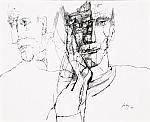Retrospective Exhibition of the Graphic Artist Lajos Szalay in Honour of his 100th Anniversary of Birth
KOGART House

“Probably the next greatest graphic artist in the world is a Hungarian by the name Lajos Szalay.” Pablo Picasso (Confirmado, Buenos Aires, June 1967)
Why draw? What drives man, since the cave drawings, to engage in this activity? What is drawing? What means or instinct of man? What does a drawing by Szalay express? Drawing is probably the most fundamental mode of visual expression. (Szalay already used drawing to communicate an important fact to those around him before he could talk.) Drawing is the keystone of visual self-expression, the basis of communicating through images, and as many will insist, the foundation of any kind of visual art. Drawing is perceiving the world through forms and proportions (and optionally, through colours), visually appropriating the universe, the primus inter pares tool of artistic self-expression.
This oeuvre exhibition is full of surprises. It now seems that we have not known Lajos Szalay (1909-1995), the painter and draughtsman, the magician of the drawing pen, the virtuoso of the line, the internationally recognized artist whose lifework spanned half a century (1930-1980). The artist now before us seems to own an oeuvre not known before. The display features award-winning paintings from his academy years (and an additional 50 from later on), prints and applied graphics (book covers, the poster of the 1959 anti-WFYS, etc.), sculptural experiments (e.g. the relief called HUNGARY 1956), ink drawings and literary illustrations – about 350 works altogether, drawn from the estate held in San Diego (USA) and Hungarian public and private collections. (In an unparalleled gesture, Szalay donated 450 drawings to Hungarian museums when he moved back to the country in 1988.)
Having lived and worked in several countries (Paris 1946-47, Argentina 1948-59, New York 1960-88, Hungary 1909-46, 1988-95), Szalay contributed to many art scenes without giving up his independence and autonomy as a Hungarian artist. (With some illustrations he did make small concessions to American taste.) He was a well-known illustrator in Paris, a teacher of drawing with a lasting influence in Argentina (graphic art in that country is now divided into a pre- and a post-Szalay era), and a frequently employed artist of the Hungarian émigré community in the West. His self-contained drawing books and the numerous illustration series earned him recognition and success (Villon, Ómagyar Mária-siralom, Shakespeare, Cervantes, Chekhov, Turgenev, Dostoyevsky, Tolstoy, Franz Kafka, Lőrincz Szabó, Attila József, Gyula Illyés, György Faludy, György Somlyó, etc.). The most important of his drawing books, one to receive international praise, was Genesis (New York, 1966), a graphic interpretation of the first book of the Bible.
Szalay’s drawings are confessions, visual self-expressions of a lyrical character, so many self-addressing poems. Through a rich inventory of emotions, dramatic states and situations, they successfully uncover the diversity of human life, from the depths of the psyche, its hidden motives and hard-to-express fears, to the cataclysmic events of 20th-century history. Szalay created individual structures, morphologically intricate line textures, drawing apparels for his figures, whether they be the heroes of Greco-Roman mythology, the dramatis personae of the Bible, the immortals of love (Erato, Song of Songs), or the victims of wars and revolutions. So many sovereign artistic forms for Man elated and tortured by the joys and horrors, the opportunities and restrictions, of the 20th century.
György Sümegi, art historian
KOGART House
1062 Budapest, Andrássy út 112.
